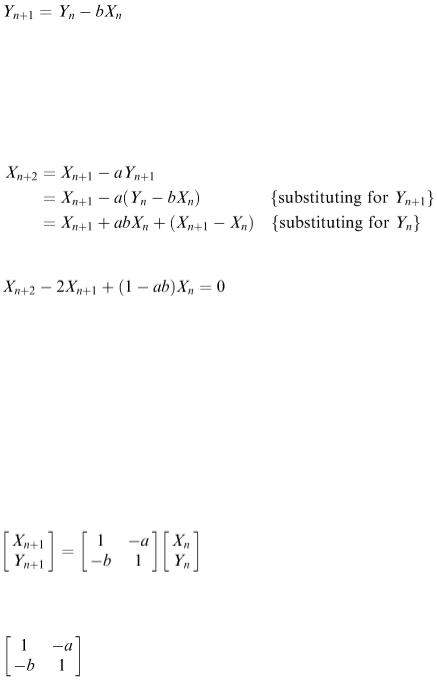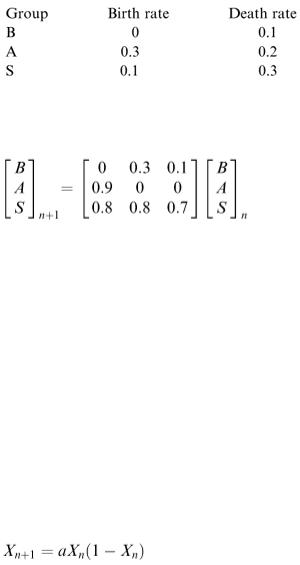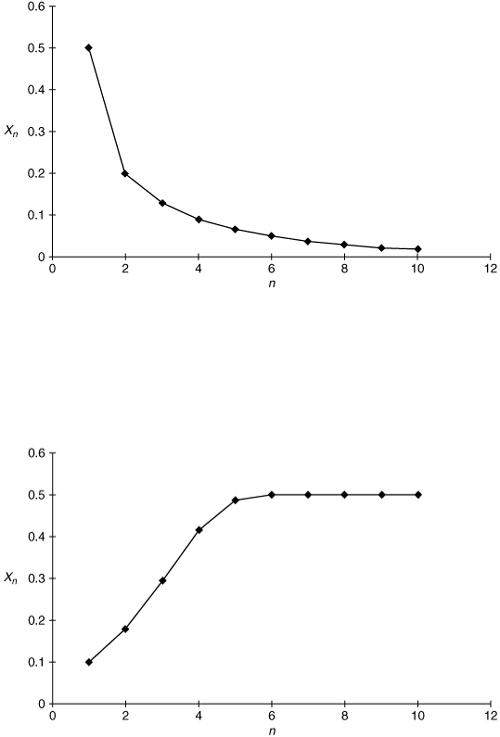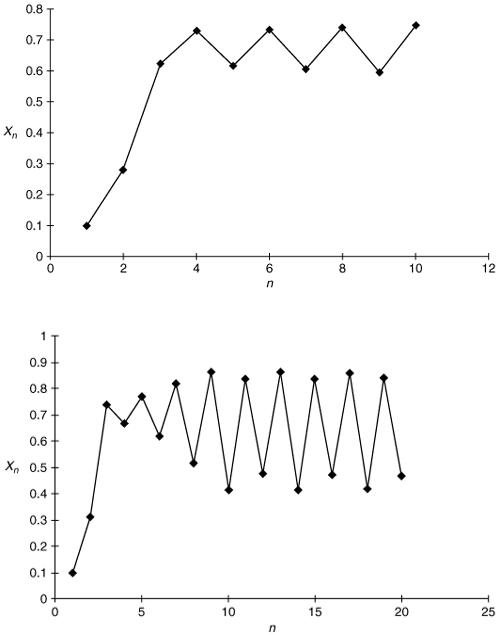
- •Preface
- •1.1 Introduction
- •1.2 Models and modelling
- •1.3 The learning process for mathematical modelling
- •Summary
- •Aims and objectives
- •2.1 Introduction
- •2.2 Examples
- •2.3 Further examples
- •Appendix 1
- •Appendix 2
- •Aims and objectives
- •3.1 Introduction
- •3.2 Definitions and terminology
- •3.3 Methodology and modelling flow chart
- •3.4 The methodology in practice
- •Background to the problem
- •Summary
- •Aims and objectives
- •4.1 Introduction
- •4.2 Listing factors
- •4.3 Making assumptions
- •4.4 Types of behaviour
- •4.5 Translating into mathematics
- •4.6 Choosing mathematical functions
- •Case 1
- •Case 2
- •Case 3
- •4.7 Relative sizes of terms
- •4.8 Units
- •4.9 Dimensions
- •4.10 Dimensional analysis
- •Summary
- •Aims and objectives
- •5.1 Introduction
- •5.2 First-order linear difference equations
- •5.3 Tending to a limit
- •5.4 More than one variable
- •5.5 Matrix models
- •5.6 Non-linear models and chaos
- •5.7 Using spreadsheets
- •Aims and objectives
- •6.1 Introduction
- •6.2 First order, one variable
- •6.3 Second order, one variable
- •6.4 Second order, two variables (uncoupled)
- •6.5 Simultaneous coupled differential equations
- •Summary
- •Aims and objectives
- •7.1 Introduction
- •7.2 Modelling random variables
- •7.3 Generating random numbers
- •7.4 Simulations
- •7.5 Using simulation models
- •7.6 Packages and simulation languages
- •Summary
- •Aims and objectives
- •8.1 Introduction
- •8.2 Data collection
- •8.3 Empirical models
- •8.4 Estimating parameters
- •8.5 Errors and accuracy
- •8.6 Testing models
- •Summary
- •Aims and objectives
- •9.1 Introduction
- •9.2 Driving speeds
- •Context
- •Problem statement
- •Formulate a mathematical model
- •Rewritten problem statement
- •Obtain the mathematical solution
- •9.3 Tax on cigarette smoking
- •Context
- •Problem statement
- •Formulate a mathematical model
- •Obtain the mathematical solution
- •9.4 Shopping trips
- •Context
- •Problem statement
- •Formulate a mathematical model
- •Obtain the mathematical solution
- •Interpret the mathematical solution
- •Using the model
- •9.5 Disk pressing
- •Context
- •Problem statement
- •Formulate a mathematical model
- •Obtain the mathematical solution
- •Interpret the mathematical solution
- •Further thoughts
- •9.6 Gutter
- •Context and problem statement
- •Formulate a mathematical model
- •Obtain the mathematical solution
- •9.7 Turf
- •Context
- •Problem statement
- •Formulate a mathematical model
- •Obtain the mathematical solution
- •Interpret the solution
- •9.8 Parachute jump
- •Context and problem statement
- •Formulate a mathematical model
- •Obtain the mathematical solution
- •9.9 On the buses
- •Context
- •Problem statement
- •Formulate a mathematical model
- •Obtain the mathematical solution
- •9.10 Further battles
- •Discrete deterministic model
- •Discrete stochastic model
- •Comparing the models
- •9.11 Snooker
- •Context
- •Problem statement
- •Formulate a mathematical model
- •Obtain the mathematical solution
- •Interpret the mathematical solution
- •9.12 Further models
- •Mileage
- •Heads or tails
- •Picture hanging
- •Motorway
- •Vehicle-merging delay at a junction
- •Family names
- •Estimating animal populations
- •Simulation of population growth
- •Needle crystals
- •Car parking
- •Overhead projector
- •Sheep farming
- •Aims and objectives
- •10.1 Introduction
- •10.2 Report writing
- •Preliminary
- •Main body
- •Appendices
- •Summary
- •General remarks
- •10.3 A specimen report
- •Contents
- •1 PRELIMINARY SECTIONS
- •1.1 Summary and conclusions
- •1.2 Glossary
- •2 MAIN SECTIONS
- •2.1 Problem statement
- •2.2 Assumptions
- •2.3 Individual testing
- •2.4 Single-stage procedure
- •2.5 Two-stage procedure
- •2.6 Results
- •2.7 Regular section procedures
- •2.8 Conclusions
- •3 APPENDICES
- •3.1 Possible extensions
- •3.2 Mathematical analysis
- •10.4 Presentation
- •Preparation
- •Giving the presentation
- •Bibliography
- •Solutions to Exercises
- •Chapter 2
- •Example 2.2 – Double wiper overlap problem
- •Chapter 4
- •Chapter 5
- •Chapter 6
- •Chapter 8
- •Index

Here we have two explicit but coupled difference equations, neither one can be solved on its own. However, given initial sizes X 0 and Y 0 for the two armies, and also given the parameters a and b, we could compute X 1 and Y 1 etc. directly from the above difference equations, probably on a spreadsheet.
An alternative approach is to eliminate one of the variables by substitution. The first equation implies that
This is
a second -order difference equation. From it we can generate a sequence of X n values provided two starting values, e.g. X 0 and X 1 , are available. Alternatively a mathematical solution for X n in terms of n can be derived. Methods for doing this can be found in the Bibliography.
Both models are considered again in chapters 6 and 9.
5.5 Matrix models
Linear difference equations involving more than one variable can be neatly expressed using vectors and matrices. We have already used this approach on p. 38, chapter 2. The state of the battle in the previous example can be represented by the vector Z n = [ X n , Y n ] and the pair of simultaneous difference equations can be written
so the progress of the battle from one step to the next can be written concisely as Z n +1 = MZ n where M is the matrix
and the solution can be written Z n = M n Z 0 . This approach is especially useful for models representing transitions between states or compartments. When developing models for populations, for example, we often want to do more than just predict the total size of the population. At any time a human population will consist of a mixture of individuals of different age, sex, occupation etc. In order to make forward planning for the provision of resources such as schools and hospitals we need to make predictions about the future numbers of individuals in different categories within the population. We have introduced this in the fish harvest model, Example 2.7.
Example 5.7
Let us take a simple and artificial example of a population of animals, which become adult and capable of reproducing at the age of one year. Suppose we represent the population at time step n in terms of

the numbers of animals in each of three categories.
B n = number of babies and young animals up to one year old A n = number of young adults up to two years old, and
S n = number of ‘senior’ adults aged two or older
There will be different annual birth and death rates for the three groups. Suppose we have the following information:
This means, for example, that 90% of babies survive to become adults and that 10% of senior adults produce one offspring per year on average. When we go from year n to year n + 1 we can put this information into matrix form as:
This is a difference equation of the form X n +1 = AX n i.e. like we had in section 5.1 except that now each X n is not a single number but a vector of three numbers and A is not a single number but a matrix.
To find out what happens to the population we only have to keep multiplying by the matrix (often called the transition matrix ). The nature of the solution, and whether we eventually reach a steady state depends on the largest eigenvalue, λ, of this matrix.
If λ > 1 then the population grows without limit.
If λ = 1 then the population converges to the eigenvector associated with λ. If λ < 1 then the population continually decreases.
(See the Bibliography for further information.)
5.6 Non-linear models and chaos
A simple (and important) example of a non-linear difference equation is:
where a is a constant and 0 < X 0 < 1. The solutions of non-linear equations reveal a much stranger and more varied behaviour than that of linear equations and in some cases show the kind of behaviour described as ‘chaos’. This is what happens with the above equation for certain values of a. We can describe the behaviour as follows.
For 0 < a < 1, X n continues to decrease towards zero as in Figure 5.6.

Figure 5.6
For 1 < a < 3, X n increases or decreases (depending on X 0 ) towards the limit 1 – 1/ a as in Figure 5.7.
For 3 < a < 3.449, after a while X n latches on to two distinct values and continues to switch between them for ever. It behaves like a sequence with period 2 as in Figure 5.8.
For 3.449 < a < 3.544, after a while X n jumps between four distinct values, i.e. it has period 4 as in Figure 5.9 and for 3.544 < a < 3.564 we get period 8.
Figure 5.7

Figure 5.8
Figure 5.9
This ‘period doubling’ continues as we continue to increase a until a approaches the special value 3.57
– when X n jumps between an infinite number of distinct values giving the appearance of a random sequence. This is chaos. It is a fairly recent discovery and has possible applications in a wide variety of areas (see the Bibliography for further information). An effect which has become known as the ‘butterfly effect’ is that a tiny alteration in
